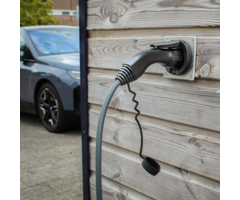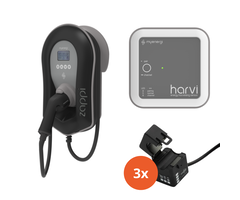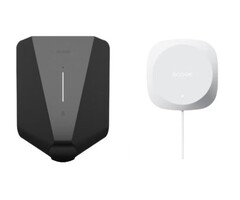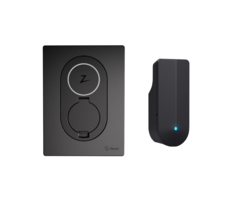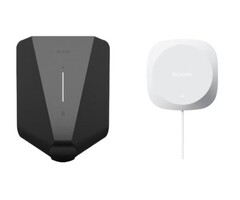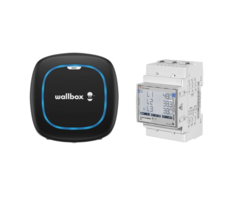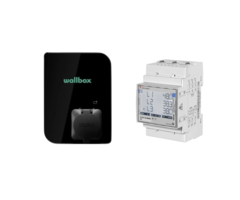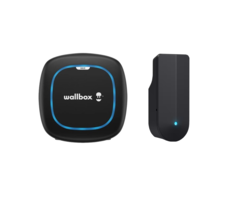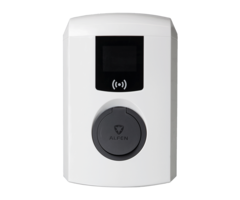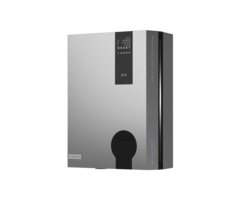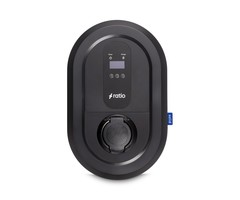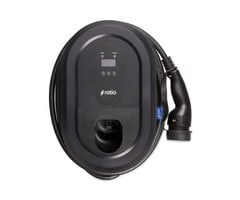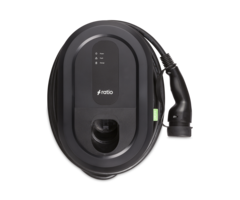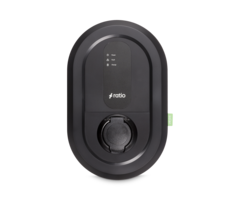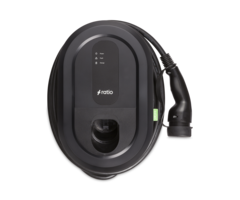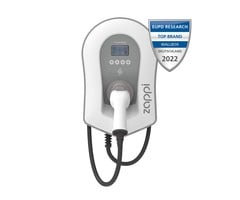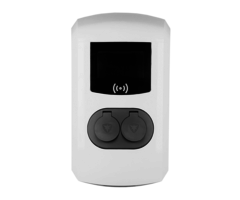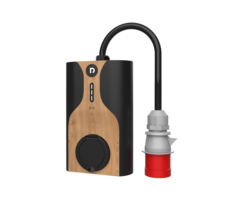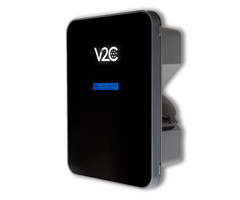Smart EV charger
EV smart charger
An EV charger with dynamic load balancing, also known as a smart EV charger, measures the total energy consumption in your home or network during car charging. This is a technology in a charging station that prevents overcharging. Moreover, it prevents sudden power outages at home while charging your electric car, while at the same time ensuring optimal charging power.
Advantages of load balancer EV charging station
The advantages of a load balancer charging station are clear. Less overcharging, efficient use and strong cost savings.
- Prevents overloading: load balancing dynamically adjusts the charging rate to avoid peak load on the power network. This minimises the risk of power outages and other network problems.
- Efficient use of resources: it ensures more efficient use of available electric resources by distributing them evenly among the connected electric vehicles, optimising the overall load on the network.
- Cost savings: by avoiding excessive demand for electric power, utilities can reduce costs for network upgrades. This also leads to lower electricity costs for users, as tariffs are often based on peak load.
Disadvantages of charge post with load balancing
The disadvantages of charge post with load balancing are rather limited. Nevertheless, it is important to know them so you can make the best decision for your specific situation.
- Complexity and cost: Charge posts with load balancing require sophisticated hardware and software to function effectively. This can increase the initial cost of purchase and installation. Maintenance and possible repairs of these complex systems can also be more expensive.
- Highly dependent on the internet: Load balancing charging stations depend on a reliable internet connection to communicate with the central management system. If this is interrupted, the management system may not be able to adjust load rates effectively.
Buy an EV smart charger
Planning to buy an EV smart charger? At Wallbox Discounter, you've come to the right place. This is because charge posts with load balancing often require specific hardware and software to work effectively. Not all charge posts are equipped with load balancing functions as standard, but ours are. Check out the various low-cost models we offer:
| EV Charger Model | Price | Power | Colour | App | Cable or socket |
|---|---|---|---|---|---|
| Ratio Solid 22 kW | €699 | 22 kW | Black | Yes | Cable or Socket |
| Wallbox Copper SB 22 kW | €775 | 22 kW | Black | Yes | Socket |
| Myenergi Zappi V2.1 22 kW socket | €889 | 22 kW | Black/White | Yes | Cable or Socket |
| Myenergi Zappi V2.1 22 kW Cable | €899 | 22 kW | Black/White | Yes | Cable or Socket |
| Raedian NEO 22 kW | €799 | 22 kW | Black/White | Yes | Cable or Socket |
| Easee Charge Max 22 kW | €999 | 22 kW | Black | Yes | Socket |
| Alfen Eve Single S-line 11 kW | €899 | 11 kW | White | Yes | Socket |
| Zaptec Go 22 kW | €669 | 22 kW | Black | Yes | Socket |
| Loady Pillar Solar 22 kW | €1299 | 22 kW | Black | No | Socket |
All our load balancing charging stations are excellent value for money and are delivered quickly and safely to your home. Curious about which load balancing charging stations we have? View our complete range for Smart EV chargers here. If you would like to know more about load balancing and how exactly it works, read the extensive blog on the subject here or contact us without obligation.
Load Balancing accessories
To ensure that your EV charger does not consume more power than is available, certain charging stations require a ‘load balancer.’ This smart device measures how much electricity is being used in the household and adjusts the charging current. This prevents your fuse box from becoming overloaded and causing a power outage. Not all EV chargers have this function as standard. Brands like Easee, Smappee, Tesla, Wallbox and Zaptec require a separate load balancer to enable Dynamic Load Balancing.
There are various load balancing devices, each with its own way of functioning and connecting. The Easee Equalizer, Wallbox Power Boost, Zaptec SenseandTibber Pulse connect to the EV charger via Wi-Fi and cable to the smart meter in the fuse box using the P1 port. These models are easy to install and work directly with your smart meter to regulate the charging current.
The Tibber Pulse is a universal device and can be used with Easee, Wallbox and Zaptec, whereas the other load balancers only work with their respective brand’s EV chargers.
If you don’t have a smart meter, the Smappee Infinity Kit and Tesla Neurio meter are available. These do not use Wi-Fi and the P1 port but measure power consumption using CT clamps that are placed around the power cables in the fuse box. This makes them suitable for more complex installations or older fuse boxes without a smart meter.
| Load balancer | Usable with these brands | Works through |
|---|---|---|
| Easee Equalizer | Easee | Wi-Fi and the P1 port of your smart meter |
| Wallbox Power Boost | Wallbox | Wi-Fi and the P1 port of your smart meter |
| Zaptec Sense | Zaptec | Wi-Fi and the P1 port of your smart meter |
| Tibber Pulse | Easee, Wallbox and Zaptec | Wi-Fi and the P1 port of your smart meter |
| Smappee Infinity Kit | Smappee | CT clamps around the power cables |
| Tesla Neurio meter | Tesla | CT clamps around the power cables |
Wallbox with load balancing?
Get your EV charger with load balancing from Wallbox discounter now and get more control over your energy bills. Our charge posts are not only budget-friendly, but guarantee years of high efficiency. Order now from Wallbox discounter and receive your load balancing charging station at your home within a few days.



